Research Trends in the Effect of Caffeine Intake on Fat Oxidation: A Bibliometric and Visual Analysis
Abstract
:1. Introduction
2. Materials and Methods
2.1. Study Design
2.2. Data Extraction
2.3. Search Strategy
2.4. Data Analysis
3. Results
3.1. Evolution in the Number of Publications
3.2. Web of Science Categories
3.3. Most Cited Documents
3.4. Scientific Journals
3.5. Publications Considering the Countries
3.6. Network between Authors
3.7. Publications Regarding Organizations
3.8. Keywords Used by Authors
4. Discussion
5. Conclusions
Author Contributions
Funding
Data Availability Statement
Acknowledgments
Conflicts of Interest
References
- Mitchell, D.C.; Knight, C.A.; Hockenberry, J.; Teplansky, R.; Hartman, T.J. Beverage Caffeine Intakes in the U.S. Food Chem. Toxicol. 2014, 63, 136–142. [Google Scholar] [CrossRef] [PubMed]
- National Coffee Association of U.S.A. Available online: https://www.ncausa.org (accessed on 6 October 2023).
- Reyes, C.; Cornelis, M. Caffeine in the Diet: Country-Level Consumption and Guidelines. Nutrients 2018, 10, 1772. [Google Scholar] [CrossRef] [PubMed]
- Wikoff, D.; Welsh, B.T.; Henderson, R.; Brorby, G.P.; Britt, J.; Myers, E.; Goldberger, J.; Lieberman, H.R.; O’Brien, C.; Peck, J.; et al. Systematic Review of the Potential Adverse Effects of Caffeine Consumption in Healthy Adults, Pregnant Women, Adolescents, and Children. Food Chem. Toxicol. 2017, 109, 585–648. [Google Scholar] [CrossRef] [PubMed]
- Saimaiti, A.; Zhou, D.-D.; Li, J.; Xiong, R.-G.; Gan, R.-Y.; Huang, S.-Y.; Shang, A.; Zhao, C.-N.; Li, H.-Y.; Li, H.-B. Dietary Sources, Health Benefits, and Risks of Caffeine. Crit. Rev. Food Sci. Nutr. 2022, 1–19. [Google Scholar] [CrossRef] [PubMed]
- Soós, R.; Gyebrovszki, Á.; Tóth, Á.; Jeges, S.; Wilhelm, M. Effects of Caffeine and Caffeinated Beverages in Children, Adolescents and Young Adults: Short Review. Int. J. Environ. Res. Public Health 2021, 18, 12389. [Google Scholar] [CrossRef] [PubMed]
- Collado-Mateo, D.; Lavín-Pérez, A.M.; Merellano-Navarro, E.; Coso, J. Del Effect of Acute Caffeine Intake on the Fat Oxidation Rate during Exercise: A Systematic Review and Meta-Analysis. Nutrients 2020, 12, 3603. [Google Scholar] [CrossRef] [PubMed]
- Aguilar-Navarro, M.; Muñoz, G.; Salinero, J.; Muñoz-Guerra, J.; Fernández-Álvarez, M.; Plata, M.; Del Coso, J. Urine Caffeine Concentration in Doping Control Samples from 2004 to 2015. Nutrients 2019, 11, 286. [Google Scholar] [CrossRef]
- Salinero, J.J.; Lara, B.; Del Coso, J. Effects of Acute Ingestion of Caffeine on Team Sports Performance: A Systematic Review and Meta-Analysis. Res. Sport. Med. 2019, 27, 238–256. [Google Scholar] [CrossRef]
- Diaz-Lara, F.J.; del Coso, J.; Portillo, J.; Areces, F.; García, J.M.; Abián-Vicén, J. Enhancement of High-Intensity Actions and Physical Performance during a Simulated Brazilian Jiu-Jitsu Competition with a Moderate Dose of Caffeine. Int. J. Sports Physiol. Perform. 2016, 11, 861–867. [Google Scholar] [CrossRef]
- Conger, S.A.; Tuthill, L.M.; Millard-Stafford, M.L. Does Caffeine Increase Fat Metabolism? A Systematic Review and Meta-Analysis. Int. J. Sport Nutr. Exerc. Metab. 2023, 33, 112–120. [Google Scholar] [CrossRef]
- Varillas-Delgado, D.; Aguilar-Navarro, M.; Muñoz, A.; López-Samanés, Á.; Ruiz-Moreno, C.; Posada-Ayala, M.; Amaro-Gahete, F.J.; Del Coso, J.; Gutiérrez-Hellín, J. Effect of 3 and 6 Mg/Kg of Caffeine on Fat Oxidation during Exercise in Healthy Active Women. Biol. Sport 2023, 40, 827–834. [Google Scholar] [CrossRef] [PubMed]
- Gutiérrez-Hellín, J.; Aguilar-Navarro, M.; Ruiz-Moreno, C.; Muñoz, A.; Varillas-Delgado, D.; Amaro-Gahete, F.J.; Del Coso, J. Effect of Caffeine Intake on Fat Oxidation Rate during Exercise: Is There a Dose–Response Effect? Eur. J. Nutr. 2023, 62, 311–319. [Google Scholar] [CrossRef] [PubMed]
- Jeukendrup, A.E.; Randell, R. Fat Burners: Nutrition Supplements That Increase Fat Metabolism. Obes. Rev. 2011, 12, 841–851. [Google Scholar] [CrossRef] [PubMed]
- Davis, J.M.; Zhao, Z.; Stock, H.S.; Mehl, K.A.; Buggy, J.; Hand, G.A. Central Nervous System Effects of Caffeine and Adenosine on Fatigue. Am. J. Physiol. Integr. Comp. Physiol. 2003, 284, R399–R404. [Google Scholar] [CrossRef] [PubMed]
- Gutiérrez-Hellín, J.; Del Coso, J. Effects of P-Synephrine and Caffeine Ingestion on Substrate Oxidation during Exercise. Med. Sci. Sports Exerc. 2018, 50, 1899–1906. [Google Scholar] [CrossRef] [PubMed]
- Ramírez-Maldonado, M.; Jurado-Fasoli, L.; del Coso, J.; Ruiz, J.R.; Amaro-Gahete, F.J. Caffeine Increases Maximal Fat Oxidation during a Graded Exercise Test: Is There a Diurnal Variation? J. Int. Soc. Sports Nutr. 2021, 18, 5. [Google Scholar] [CrossRef] [PubMed]
- Ruiz-Moreno, C.; Gutiérrez-Hellín, J.; Amaro-Gahete, F.J.; González-García, J.; Giráldez-Costas, V.; Pérez-García, V.; Del Coso, J. Caffeine Increases Whole-Body Fat Oxidation during 1 h of Cycling at Fatmax. Eur. J. Nutr. 2021, 60, 2077–2085. [Google Scholar] [CrossRef]
- Gutiérrez-Hellín, J.; Varillas-Delgado, D. Energy Drinks and Sports Performance, Cardiovascular Risk, and Genetic Associations; Future Prospects. Nutrients 2021, 13, 715. [Google Scholar] [CrossRef]
- Yang, A.; Palmer, A.A.; de Wit, H. Genetics of Caffeine Consumption and Responses to Caffeine. Psychopharmacology 2010, 211, 245–257. [Google Scholar] [CrossRef]
- Djordjevic, N.; Ghotbi, R.; Jankovic, S.; Aklillu, E. Induction of CYP1A2 by Heavy Coffee Consumption Is Associated with the CYP1A2 −163C>A Polymorphism. Eur. J. Clin. Pharmacol. 2010, 66, 697–703. [Google Scholar] [CrossRef]
- Ato, M.; López-García, J.J.; Benavente, A. A Classification System for Research Designs in Psychology. Ann. Psychol. 2013, 29, 1038–1059. [Google Scholar] [CrossRef]
- Montero, I.; León, O.G. A Guide for Naming Research Studies in Psychology. Int. J. Clin. Health Psychol. 2007, 7, 847–862. [Google Scholar]
- Contreras-Barraza, N.; Madrid-Casaca, H.; Salazar-Sepúlveda, G.; Garcia-Gordillo, M.Á.; Adsuar, J.C.; Vega-Muñoz, A. Bibliometric Analysis of Studies on Coffee/Caffeine and Sport. Nutrients 2021, 13, 3234. [Google Scholar] [CrossRef] [PubMed]
- Hernández-Beltrán, V.; Espada, M.C.; Santos, F.J.; Ferreira, C.C.; Gamonales, J.M. Documents Publication Evolution (1990–2022) Related to Physical Activity and Healthy Habits, a Bibliometric Review. Healthcare 2023, 11, 1669. [Google Scholar] [CrossRef] [PubMed]
- Gamonales, J.M.; Hernández-Beltrán, V.; Ocete, C.; Franco, E.; Mendoza, N. Evolution of Sports-Related Manuscripts for People with Intellectual Disability. Bibliometric Review. Rev. Educ. Inclusiva 2023, 16, 104–118. [Google Scholar]
- Orejuela-Aristizabal, D.F.; Cardona-Orejuela, J.S.; Rengifo-Cruz, R. Bibliometric Analysis of Scientific Production in the Swimming Field. Retos Nuevas Tend. En Educ. Física Deport. Y Recreación 2023, 47, 215–220. [Google Scholar] [CrossRef]
- Gamonales, J.M.; Muñoz-Jiménez, J.; León, K.; Ibáñez, S.J. 5-a-Side Football for Individuals with Visual Impairments: A Review of the Literature. Eur. J. Adapt. Phys. Act. 2018, 11, 4. [Google Scholar] [CrossRef]
- Price, D.D.S. A General Theory of Bibliometric and Other Cumulative Advantage Processes. J. Am. Soc. Inf. Sci. 1976, 27, 292–306. [Google Scholar] [CrossRef]
- Coile, R.C. Lotka’s Frequency Distribution of Scientific Productivity. J. Am. Soc. Inf. Sci. 1977, 28, 366–370. [Google Scholar] [CrossRef]
- Hirsch, J.E. An Index to Quantify an Individual’s Scientific Research Output. Proc. Natl. Acad. Sci. USA 2005, 102, 16569–16572. [Google Scholar] [CrossRef]
- Crespo, N.; Simoes, N. Publication Performance Through the Lens of the H-index: How Can We Solve the Problem of the Ties? Soc. Sci. Q. 2019, 100, 2495–2506. [Google Scholar] [CrossRef]
- Campos-Soto, N.; Ramos Navas-Parejo, M.; Moreno-Guerrero, A.J. Realidad Virtual y Motivación En El Contexto Educativo: Estudio Bibliométrico de Los Últimos Veinte Años de Scopus. Alteridad 2019, 15, 47–60. [Google Scholar] [CrossRef]
- Valderrama-Zurián, J.C.; García-Zorita, C.; Marugán-Lázaro, S.; Sanz-Casado, E. Comparison of MeSH Terms and KeyWords Plus Terms for More Accurate Classification in Medical Research Fields. A Case Study in Cannabis Research. Inf. Process. Manag. 2021, 58, 102658. [Google Scholar] [CrossRef]
- Vega-Muñoz, A.; Salazar-Sepúlveda, G.; Contreras-Barraza, N.; Araya-Silva, L. Scientific Mapping of Coastal Governance: Global Benchmarks and Trends. J. Mar. Sci. Eng. 2022, 10, 751. [Google Scholar] [CrossRef]
- Uribe-Toril, J.; Ruiz-Real, J.; Haba-Osca, J.; de Pablo Valenciano, J. Forests’ First Decade: A Bibliometric Analysis Overview. Forests 2019, 10, 72. [Google Scholar] [CrossRef]
- Dulloo, A.G.; Duret, C.; Rohrer, D.; Girardier, L.; Mensi, N.; Fathi, M.; Chantre, P.; Vandermander, J. Efficacy of a Green Tea Extract Rich in Catechin Polyphenols and Caffeine in Increasing 24-h Energy Expenditure and Fat Oxidation in Humans. Am. J. Clin. Nutr. 1999, 70, 1040–1045. [Google Scholar] [CrossRef] [PubMed]
- Graham, T.E. Caffeine and Exercise. Sport. Med. 2001, 31, 785–807. [Google Scholar] [CrossRef]
- Sinha, R.A.; Farah, B.L.; Singh, B.K.; Siddique, M.M.; Li, Y.; Wu, Y.; Ilkayeva, O.R.; Gooding, J.; Ching, J.; Zhou, J.; et al. Caffeine Stimulates Hepatic Lipid Metabolism by the Autophagy-Lysosomal Pathway in Mice. Hepatology 2014, 59, 1366–1380. [Google Scholar] [CrossRef]
- Rains, T.M.; Agarwal, S.; Maki, K.C. Antiobesity Effects of Green Tea Catechins: A Mechanistic Review. J. Nutr. Biochem. 2011, 22, 1–7. [Google Scholar] [CrossRef]
- Westerterp-Plantenga, M.S.; Lejeune, M.P.G.M.; Kovacs, E.M.R. Body Weight Loss and Weight Maintenance in Relation to Habitual Caffeine Intake and Green Tea Supplementation. Obes. Res. 2005, 13, 1195–1204. [Google Scholar] [CrossRef]
- Zheng, G.; Sayama, K.; Okubo, T.; Juneja, L.R.; Oguni, I. Anti-Obesity Effects of Three Major Components of Green Tea, Catechins, Caffeine and Theanine, in Mice. In Vivo 2004, 18, 55–62. [Google Scholar] [PubMed]
- Hursel, R.; Viechtbauer, W.; Westerterp-Plantenga, M.S. The Effects of Green Tea on Weight Loss and Weight Maintenance: A Meta-Analysis. Int. J. Obes. 2009, 33, 956–961. [Google Scholar] [CrossRef] [PubMed]
- Hodgson, A.B.; Randell, R.K.; Jeukendrup, A.E. The Metabolic and Performance Effects of Caffeine Compared to Coffee during Endurance Exercise. PLoS ONE 2013, 8, e59561. [Google Scholar] [CrossRef]
- Venables, M.C.; Hulston, C.J.; Cox, H.R.; Jeukendrup, A.E. Green Tea Extract Ingestion, Fat Oxidation, and Glucose Tolerance in Healthy Humans. Am. J. Clin. Nutr. 2008, 87, 778–784. [Google Scholar] [CrossRef] [PubMed]
- Kovacs, E.M.R.; Stegen, J.H.C.H.; Brouns, F. Effect of Caffeinated Drinks on Substrate Metabolism, Caffeine Excretion, and Performance. J. Appl. Physiol. 1998, 85, 709–715. [Google Scholar] [CrossRef] [PubMed]
- Rey-Martí, A.; Ribeiro-Soriano, D.; Palacios-Marqués, D. A Bibliometric Analysis of Social Entrepreneurship. J. Bus. Res. 2016, 69, 1651–1655. [Google Scholar] [CrossRef]
- Duque-Oliva, E.J.; Cervera-Taulet, A.; Rodríguez Romero, C. A Bibliometric Analysis of Models Measuring the Concept of Perceived Quality in Providing Internet Service. Innovar 2006, 16, 223–243. [Google Scholar]
- Mukherjee, D.; Lim, W.M.; Kumar, S.; Donthu, N. Guidelines for Advancing Theory and Practice through Bibliometric Research. J. Bus. Res. 2022, 148, 101–115. [Google Scholar] [CrossRef]
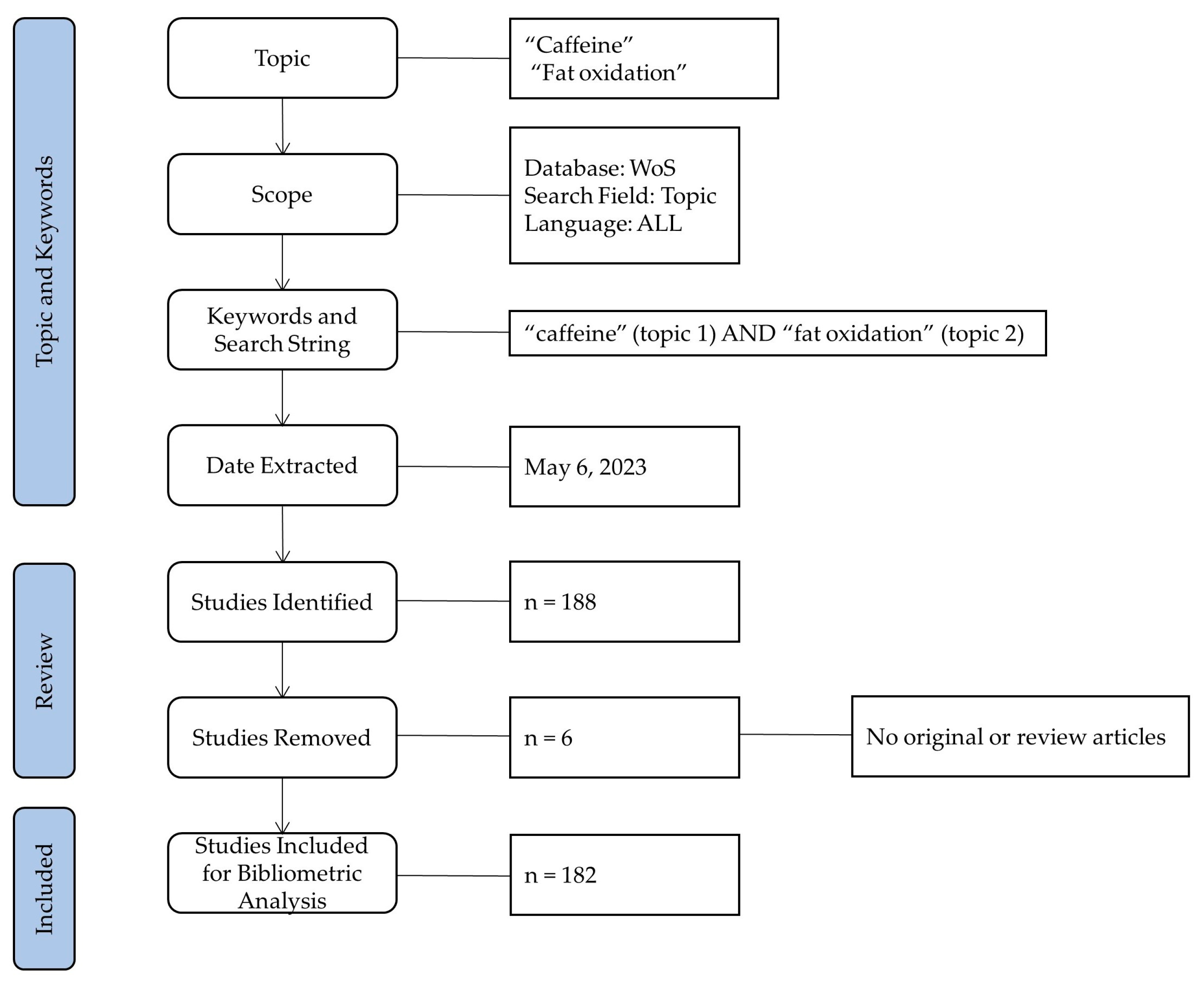
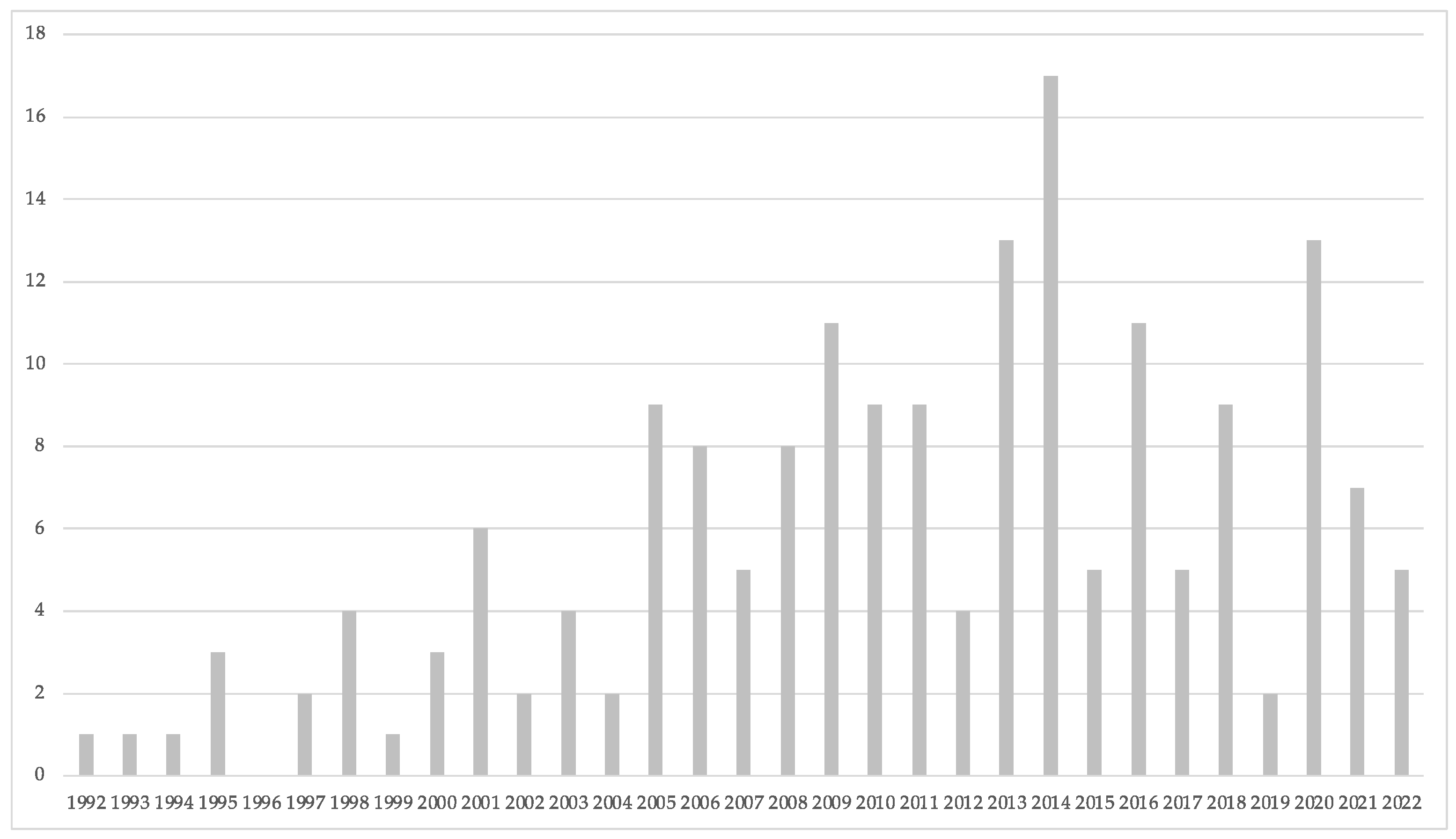

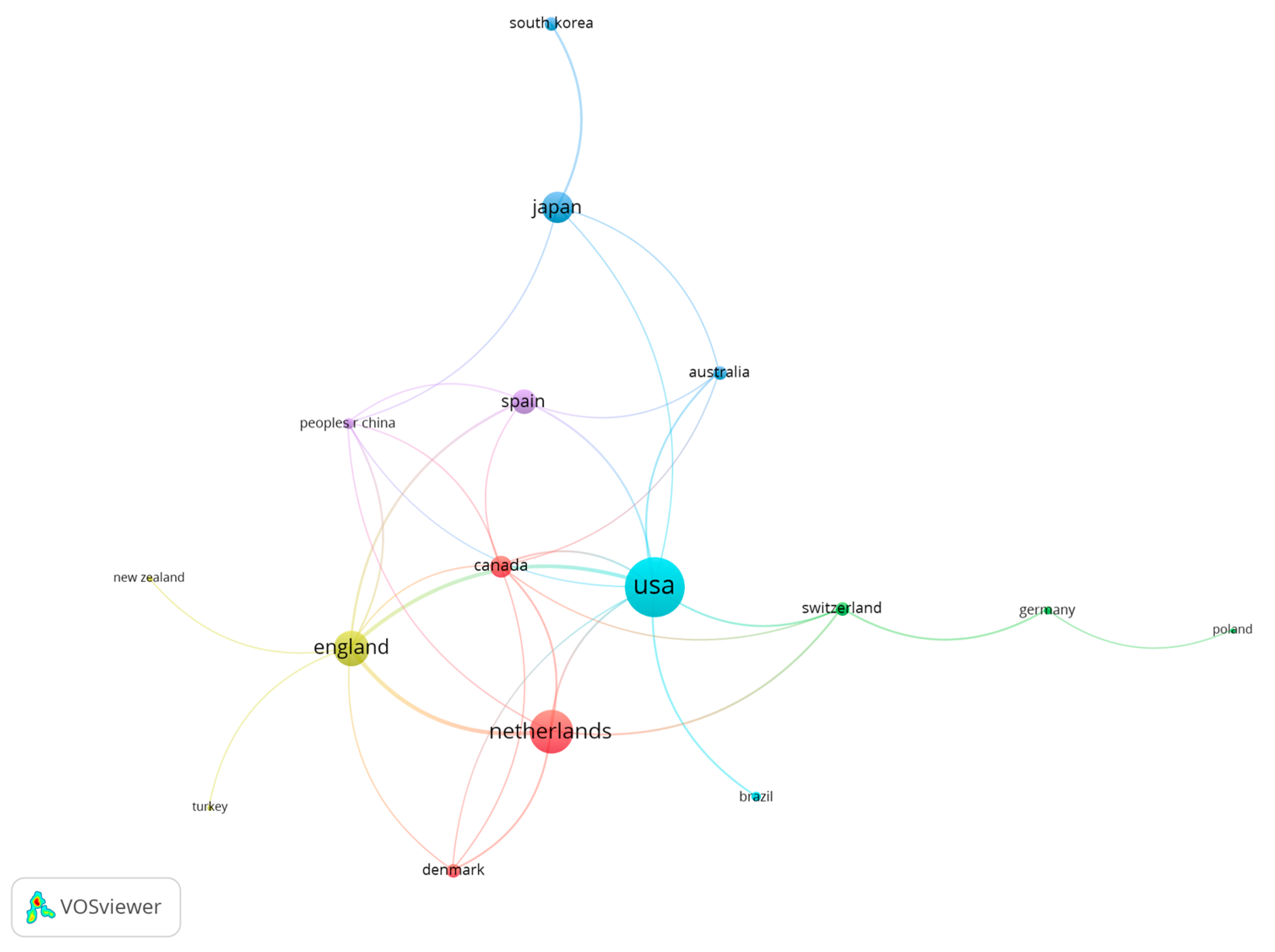
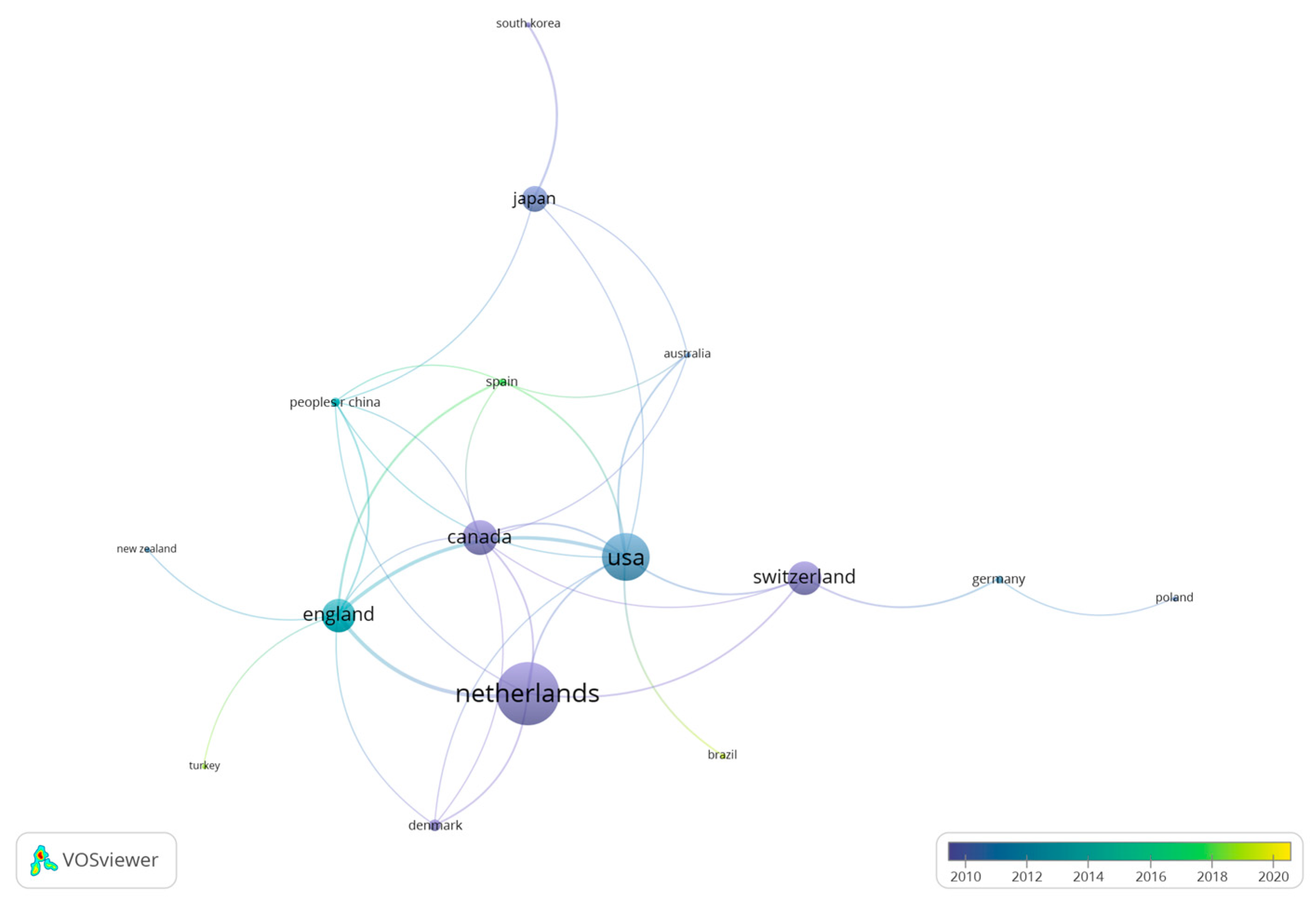
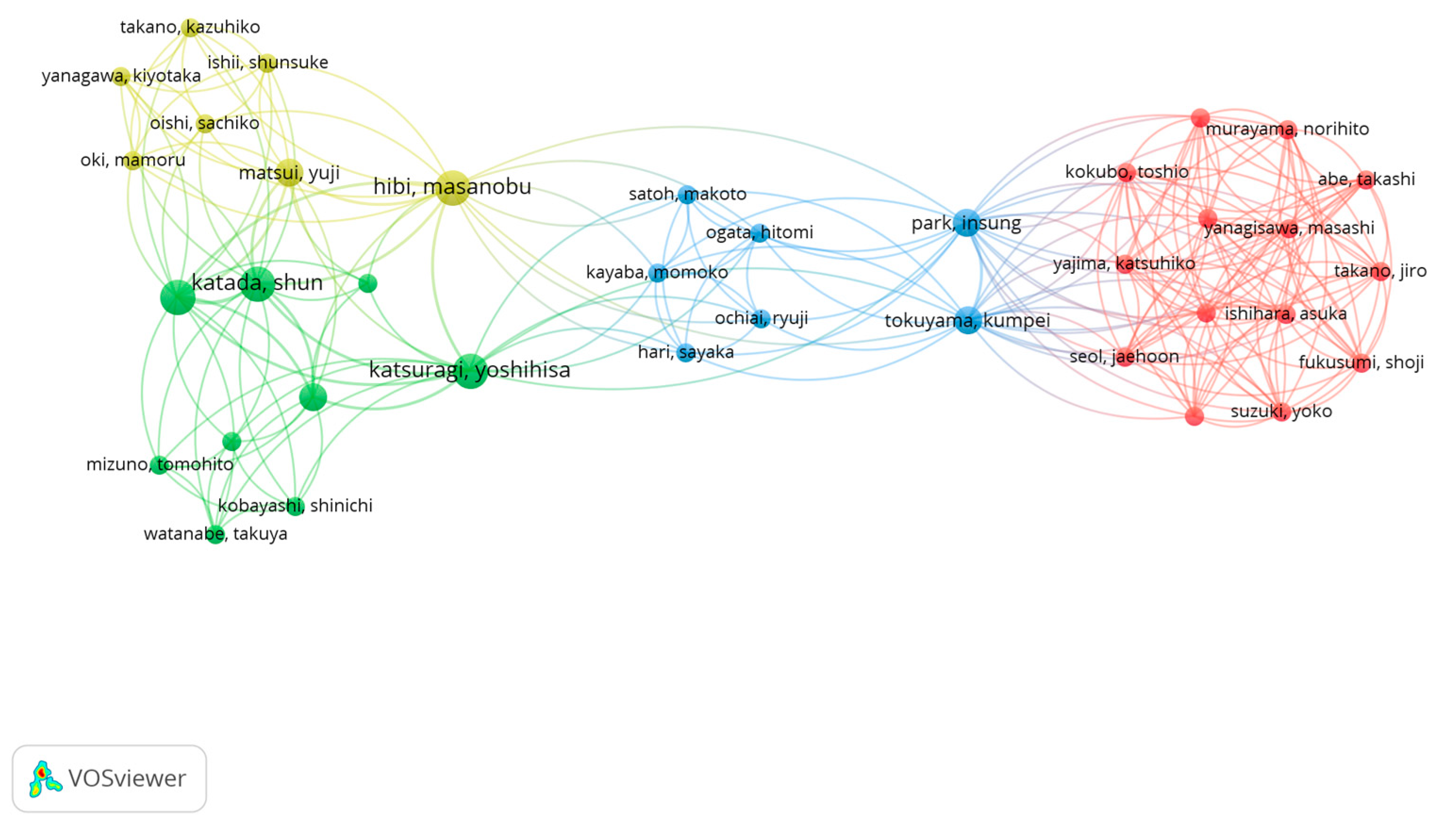
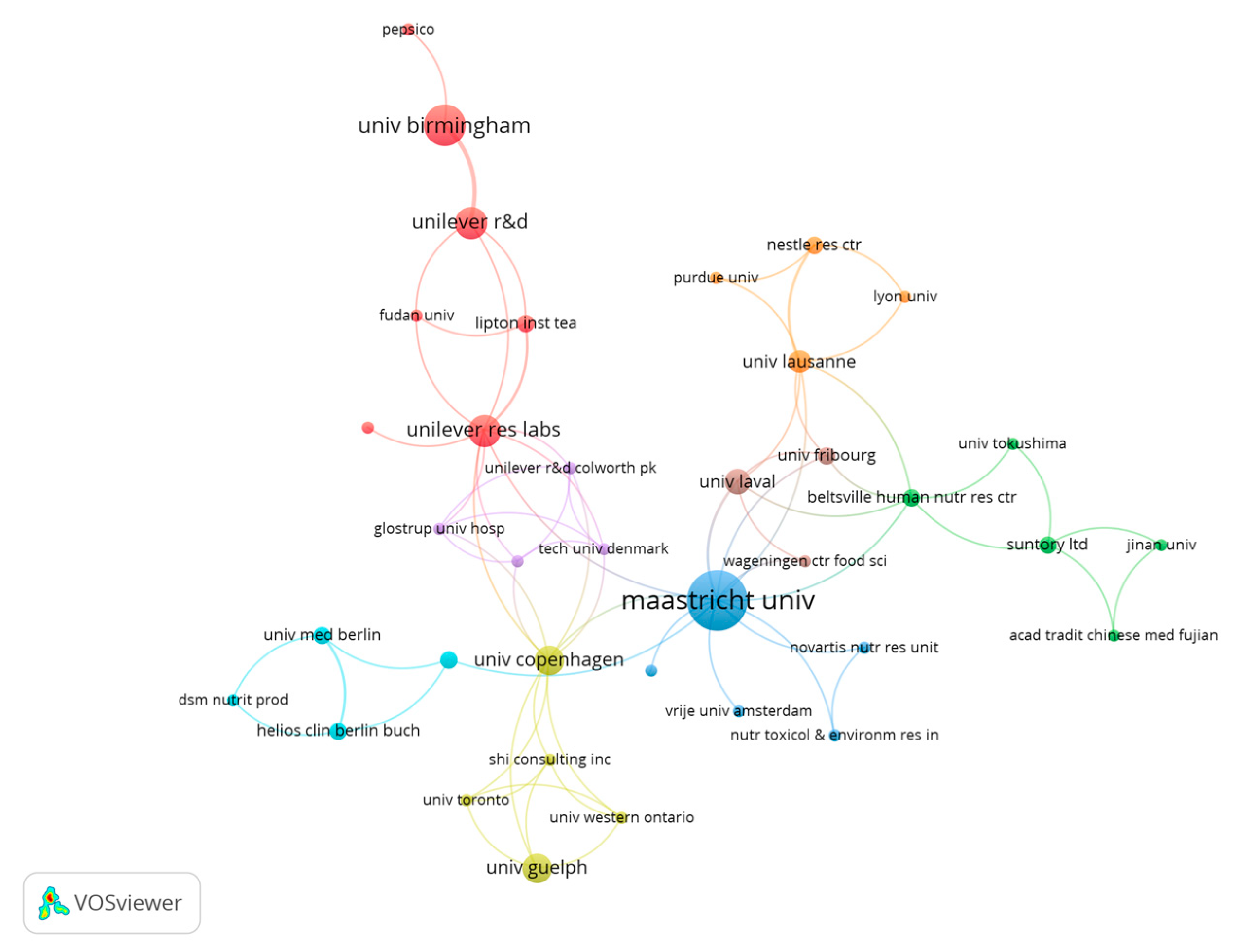

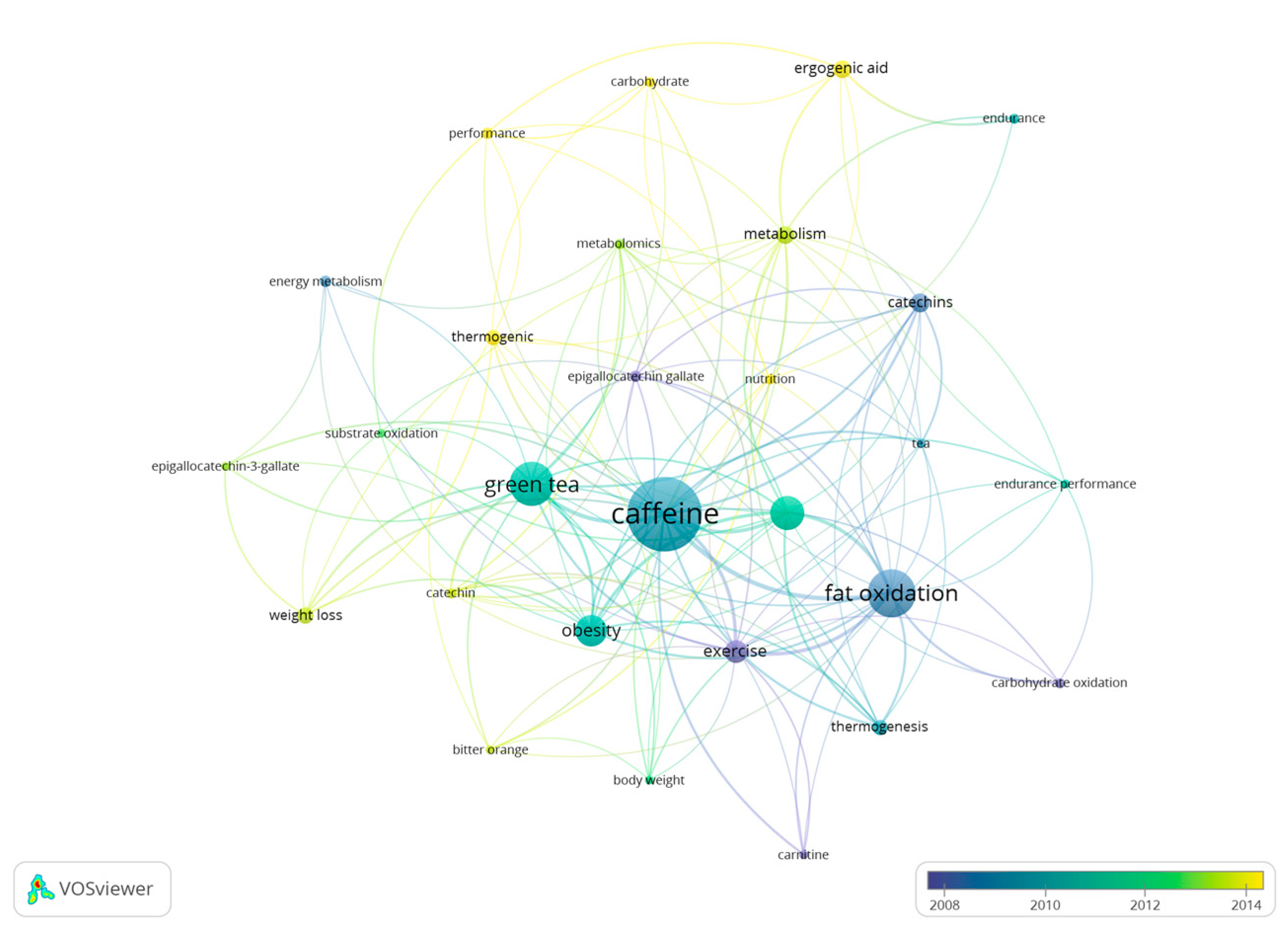
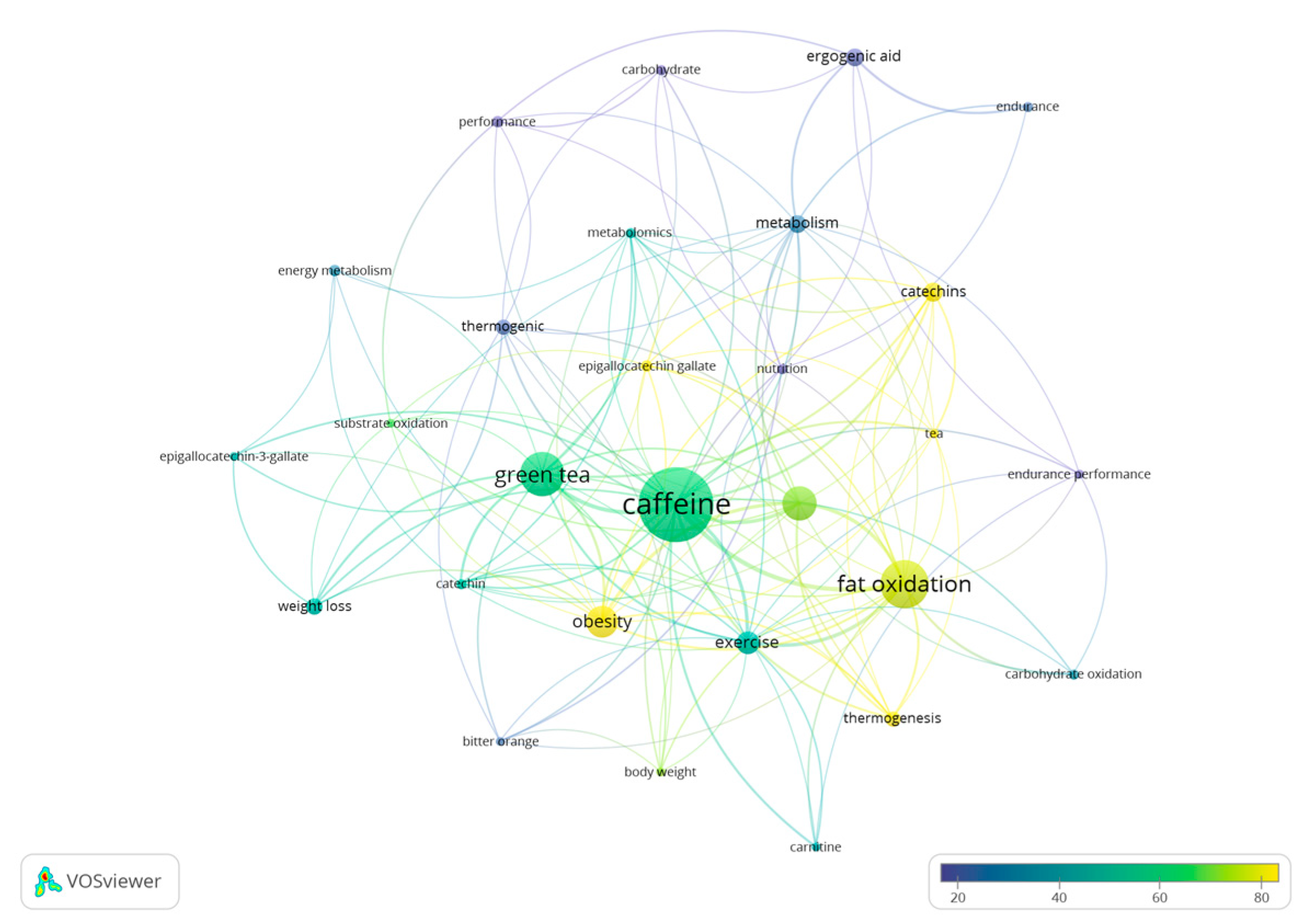
| Category | n | % |
|---|---|---|
| Nutrition and Dietetics | 108 | 59.34 |
| Sport Sciences | 48 | 26.37 |
| Endocrinology and Metabolism | 25 | 13.74 |
| Physiology | 19 | 10.44 |
| Food Science and Technology | 12 | 6.59 |
| Biochemistry and Molecular Biology | 8 | 4.40 |
| Behavioral Sciences | 5 | 2.75 |
| Medicine, Research and Experimental | 5 | 2.75 |
| Multidisciplinary Sciences | 5 | 2.75 |
| Agriculture, Multidisciplinary | 4 | 2.20 |
| Title | Authors | Journal Title | Publication Year | Total Citations | Average Citations per Year |
|---|---|---|---|---|---|
| Efficacy of a green tea extract rich in catechin polyphenols and caffeine in increasing 24-h energy expenditure and fat oxidation in humans | Dulloo et al. [37] | American Journal of Clinical Nutrition | 1999 | 644 | 25.76 |
| Caffeine and exercise—Metabolism, endurance and performance | Graham [38] | Sports Medicine | 2001 | 521 | 22.65 |
| Antiobesity effects of green tea catechins: a mechanistic review | Rains et al. [40] | Journal of Nutritional Biochemistry | 2011 | 287 | 22.08 |
| Caffeine Stimulates Hepatic Lipid Metabolism by the Autophagy-Lysosomal Pathway in Mice | Sinha et al. [39] | Hepatology | 2014 | 230 | 23.00 |
| Body weight loss and weight maintenance in relation to habitual caffeine intake and green tea supplementation | Westerterp-Plantenga et al. [41] | Obesity Research | 2005 | 224 | 11.79 |
| Anti-obesity effects of three major components of green tea, catechins, caffeine and theanine, in mice | Zheng et al. [42] | In Vivo | 2004 | 220 | 11.00 |
| The effects of green tea on weight loss and weight maintenance: a meta-analysis | Hursel et al. [43] | International Journal of Obesity | 2009 | 205 | 13.67 |
| The Metabolic and Performance Effects of Caffeine Compared to Coffee during Endurance Exercise | Hodgson et al. [44] | PLoS ONE | 2013 | 204 | 18.55 |
| Green tea extract ingestion, fat oxidation, and glucose tolerance in healthy humans | Venables et al. [45] | American Journal of Clinical Nutrition | 2008 | 197 | 12.31 |
| Effect of caffeinated drinks on substrate metabolism, caffeine excretion, and performance | Kovacs et al. [46] | Journal of Applied Physiology | 1998 | 178 | 6.85 |
| Journal | n | % | IF * |
|---|---|---|---|
| Nutrients | 12 | 6.59 | 5.9 |
| British Journal of Nutrition | 10 | 5.49 | 3.6 |
| Medicine and Science in Sports and Exercise | 9 | 4.94 | 5.4 |
| American Journal of Clinical Nutrition | 8 | 4.39 | 7.1 |
| Journal of The International Society of Sports Nutrition | 8 | 4.39 | 5.1 |
| Journal of Nutritional Science and Vitaminology | 7 | 3.84 | 1.6 |
| European Journal of Nutrition | 6 | 3.29 | 5.0 |
| International Journal of Obesity | 5 | 2.74 | 4.9 |
| International Journal of Sport Nutrition and Exercise Metabolism | 5 | 2.74 | 2.5 |
| Applied Physiology Nutrition and Metabolism | 4 | 2.19 | 3.4 |
| Author | n | % | H Index |
|---|---|---|---|
| Westerterp-Plantenga, M.S. | 16 | 8.79 | 65 |
| Jeukendrup, A.E. | 11 | 6.04 | 72 |
| Hursel, R. | 10 | 5.49 | 17 |
| Del Coso, J. | 9 | 4.95 | 37 |
| Lim, K. | 9 | 4.95 | 23 |
| Kovacs, E.M. | 8 | 4.40 | 25 |
| Mela, D.J. | 8 | 4.40 | 41 |
| Hodgson, A.B. | 7 | 3.85 | 10 |
| Randell, R.K. | 7 | 3.85 | 13 |
| Gutiérrez-Hellín, J. | 6 | 3.30 | 11 |
Disclaimer/Publisher’s Note: The statements, opinions and data contained in all publications are solely those of the individual author(s) and contributor(s) and not of MDPI and/or the editor(s). MDPI and/or the editor(s) disclaim responsibility for any injury to people or property resulting from any ideas, methods, instructions or products referred to in the content. |
© 2023 by the authors. Licensee MDPI, Basel, Switzerland. This article is an open access article distributed under the terms and conditions of the Creative Commons Attribution (CC BY) license (https://creativecommons.org/licenses/by/4.0/).
Share and Cite
Gutiérrez-Hellín, J.; Del Coso, J.; Espada, M.C.; Hernández-Beltrán, V.; Ferreira, C.C.; Varillas-Delgado, D.; Mendoza Laiz, N.; Roberts, J.D.; Gamonales, J.M. Research Trends in the Effect of Caffeine Intake on Fat Oxidation: A Bibliometric and Visual Analysis. Nutrients 2023, 15, 4320. https://doi.org/10.3390/nu15204320
Gutiérrez-Hellín J, Del Coso J, Espada MC, Hernández-Beltrán V, Ferreira CC, Varillas-Delgado D, Mendoza Laiz N, Roberts JD, Gamonales JM. Research Trends in the Effect of Caffeine Intake on Fat Oxidation: A Bibliometric and Visual Analysis. Nutrients. 2023; 15(20):4320. https://doi.org/10.3390/nu15204320
Chicago/Turabian StyleGutiérrez-Hellín, Jorge, Juan Del Coso, Mário C. Espada, Víctor Hernández-Beltrán, Cátia C. Ferreira, David Varillas-Delgado, Nuria Mendoza Laiz, Justin D. Roberts, and José M. Gamonales. 2023. "Research Trends in the Effect of Caffeine Intake on Fat Oxidation: A Bibliometric and Visual Analysis" Nutrients 15, no. 20: 4320. https://doi.org/10.3390/nu15204320
APA StyleGutiérrez-Hellín, J., Del Coso, J., Espada, M. C., Hernández-Beltrán, V., Ferreira, C. C., Varillas-Delgado, D., Mendoza Laiz, N., Roberts, J. D., & Gamonales, J. M. (2023). Research Trends in the Effect of Caffeine Intake on Fat Oxidation: A Bibliometric and Visual Analysis. Nutrients, 15(20), 4320. https://doi.org/10.3390/nu15204320












